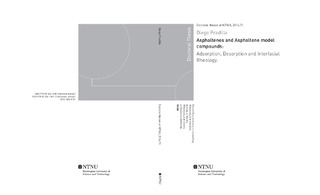| dc.contributor.author | Pradilla, Diego | |
| dc.date.accessioned | 2016-04-04T13:15:44Z | |
| dc.date.available | 2016-04-04T13:15:44Z | |
| dc.date.issued | 2016 | |
| dc.identifier.isbn | 978-82-326-1481-3 | |
| dc.identifier.issn | 1503-8181 | |
| dc.identifier.uri | http://hdl.handle.net/11250/2383810 | |
| dc.description.abstract | There are numerous problems encountered during extraction, production, transportation and
refining of crude oil. Most of these problems are typically oil-specific, meaning that they
depend upon the source of the oil, and sometimes they are reservoir-specific, meaning that
they depend on the stage of extraction (primary, secondary or enhanced recovery).
Nevertheless, a great part of the problems are related to the indigenous surface-active species
such as asphaltenes, naphthenates and resins.
The definition of asphaltenes rather than being a single molecule is instead based on a
solubility class. This means that they are polydisperse in nature which leads to differences in
properties and composition. Asphaltenes are responsible for stabilizing water-in-oil
emulsions by forming a mechanically strong gel at the interface that prevents droplet
coalescence. Asphaltenes are also known to precipitate and under certain conditions
(pressure, temperature, composition) form deposit layers which could lead to plug formation.
All this issues generate deficits in flow assurance and evidently, increases in the operational
costs.
Two strategies might be implemented to further advance in the understanding of the
mechanisms involved in asphaltene adsorption onto various interfaces (liquid-liquid or solidliquid).
(i) Fractionation or (ii) model compounds. The first strategy explores the different
sub-fractions that are obtained at different solvent/precipitant ratios using indigenous
asphaltenes. The second strategy is to design a molecule, or group of molecules with defined
functionalities that mimic the main known asphaltene properties, for instance self-association
in solution and interfacial behavior.
In this thesis, the different publications were aimed to study and explore possible solutions to
the several problems stated. In the first and second publications, adsorption and desorption
aspects of asphaltenes and demulsifiers at the liquid-liquid interface were explored.
Furthermore, interactions between asphaltenes and demulsifiers were studied via interfacial
tension measurements and interfacial dilatational rheology. The results shed light on the
mechanisms involved during chemical demulsification of water-in-crude oil emulsions. In the
third publication, rheology and sorption aspects of asphaltene model compounds at the liquidliquid
interface were studied. The main goal of this publication was to establish the interfacial
properties inherent to asphaltenes captured by a set of asphaltene model compounds
developed at the Ugelstad laboratory. Similarly, in the fourth publication adsorption of asphaltenes and asphaltene model compounds onto the solid-liquid surface was studied. In
this study, the determination of the adsorption enthalpy via microcalorimetry allowed to
elucidate the type of bond and the driving force for adsorption onto surfaces of different
nature.
With these publications, a complete study at the liquid-liquid interface and the solid-liquid
surface was developed for asphaltenes and asphaltene model compounds. This provides a
fundamental framework for model systems that can be used to understand the behavior in real
applications. | nb_NO |
| dc.language.iso | eng | nb_NO |
| dc.publisher | NTNU | nb_NO |
| dc.relation.ispartofseries | Doctoral thesis at NTNU;2016:71 | |
| dc.relation.haspart | Paper 1:
Pradilla Ragua, Diego Camilo; Simon, Sebastien Charles; Sjøblom, Johan.
Mixed interfaces of asphaltenes and model demulsifiers part I: Adsorption and desorption of single components. Colloids and Surfaces A: Physicochemical and Engineering Aspects 2015 ;Volum 466. s. 45-56
<a href="http://dx.doi.org/ 10.1016/j.colsurfa.2014.10.051" target="_blank"> http://dx.doi.org/ 10.1016/j.colsurfa.2014.10.051</a>
This article is reprinted with kind permission from Elsevier, sciencedirect.com | en |
| dc.relation.haspart | Paper 2:
Pradilla Ragua, Diego Camilo; Simon, Sebastien Charles; Sjøblom, Johan.
Mixed Interfaces of Asphaltenes and Model Demulsifiers, Part II: Study of Desorption Mechanisms at Liquid/Liquid Interfaces. Energy & Fuels 2015 ;Volum 29.(9) s. 5507-5518
<a href="http://dx.doi.org/10.1021/acs.energyfuels.5b01302" target="_blank"> http://dx.doi.org/ 10.1021/acs.energyfuels.5b01302</a>
Copyright © 2015 American Chemical Society | |
| dc.relation.haspart | Paper 3:
Pradilla, Diego., Simon, Sébastien., Sjöblom, Johan., Samaniuk, Joseph., Skrzypiec, Marta.,
Vermant, Jan.
Sorption and interfacial rheology study of model asphaltene compounds. -
Accepted and published in Langmuir, 2016, 32 (12), pp 2900–2911
<a href="http://dx.doi.org/10.1021/acs.langmuir.6b00195" target="_blank"> http://dx.doi.org/ 10.1021/acs.langmuir.6b00195</a>
Copyright © 2016 American Chemical Society | |
| dc.relation.haspart | Paper 4:
Pradilla, Diego., Subramanian, Sreedhar., Simon, Sébastien., Sjöblom, Johan., Beurroies,
Isabelle., Denoyel, Renaud.
A microcalorimetry study on the adsorption of asphaltenes and model asphaltene compounds
at the liquid-solid surface. - Is not included due to copyright | |
| dc.title | Asphaltenes and Asphaltene model compounds: Adsorption, Desorption and Interfacial Rheology. | nb_NO |
| dc.type | Doctoral thesis | nb_NO |
| dc.subject.nsi | VDP::Technology: 500::Chemical engineering: 560 | nb_NO |

